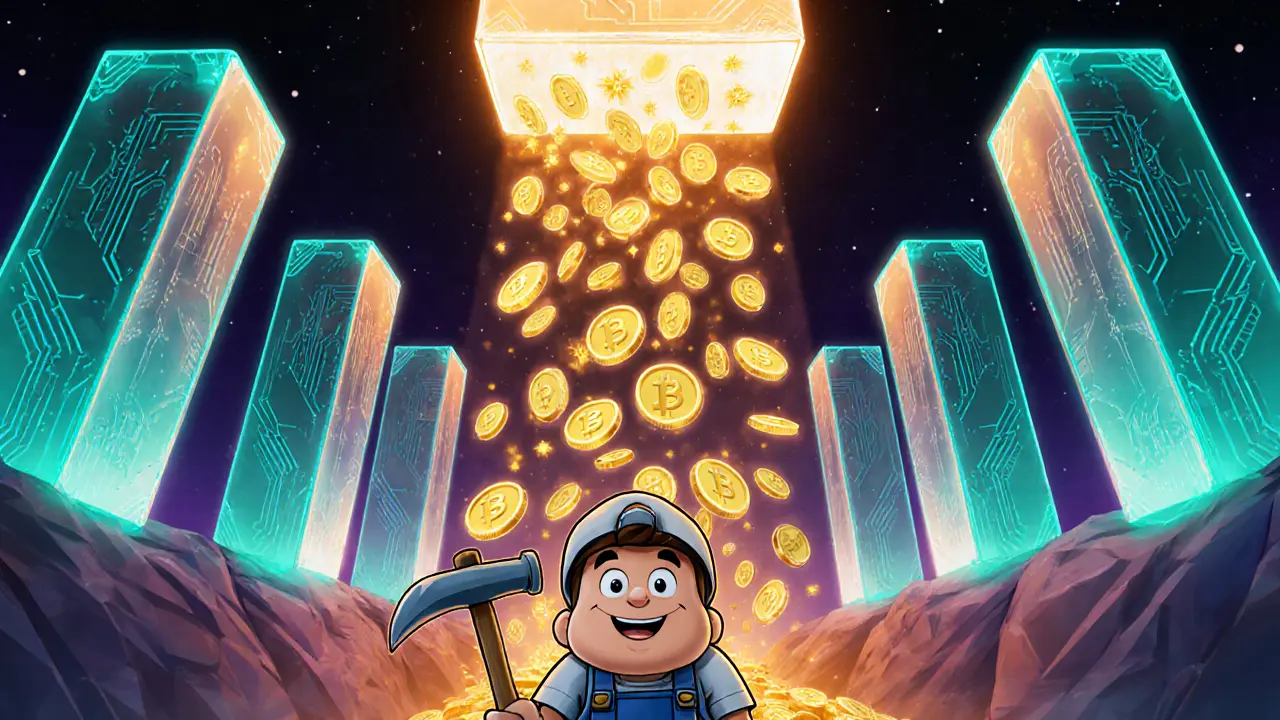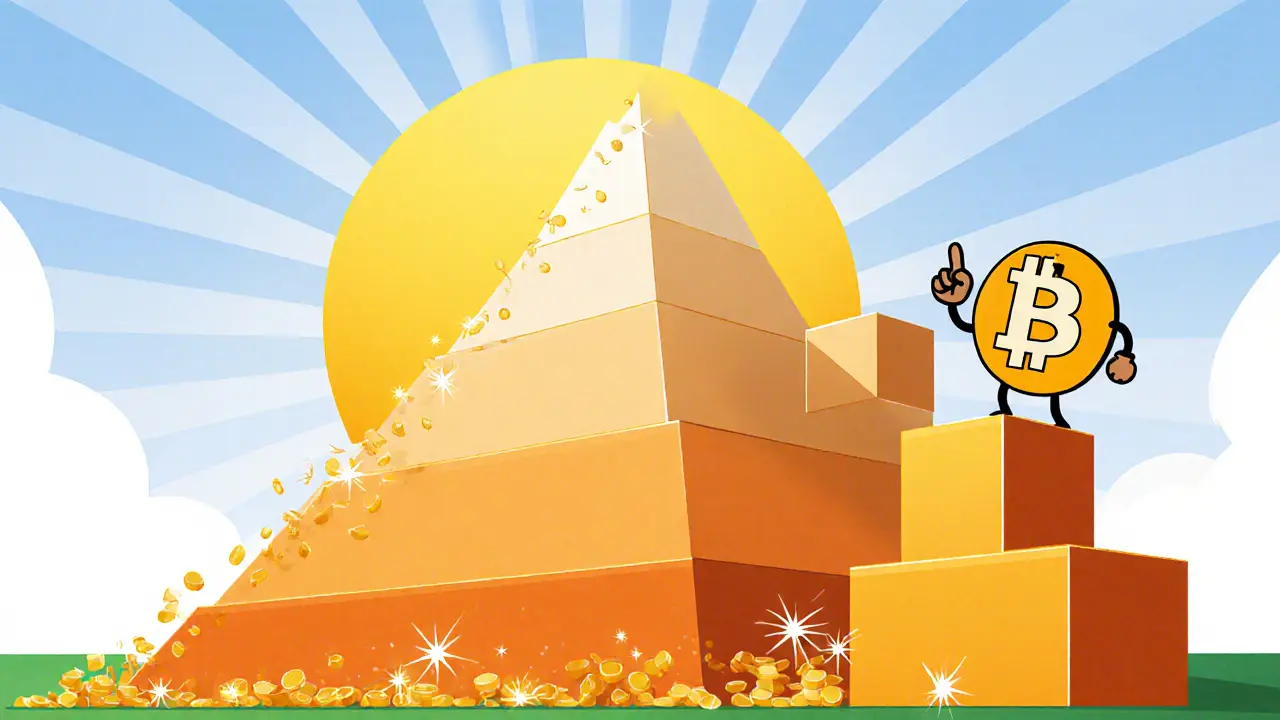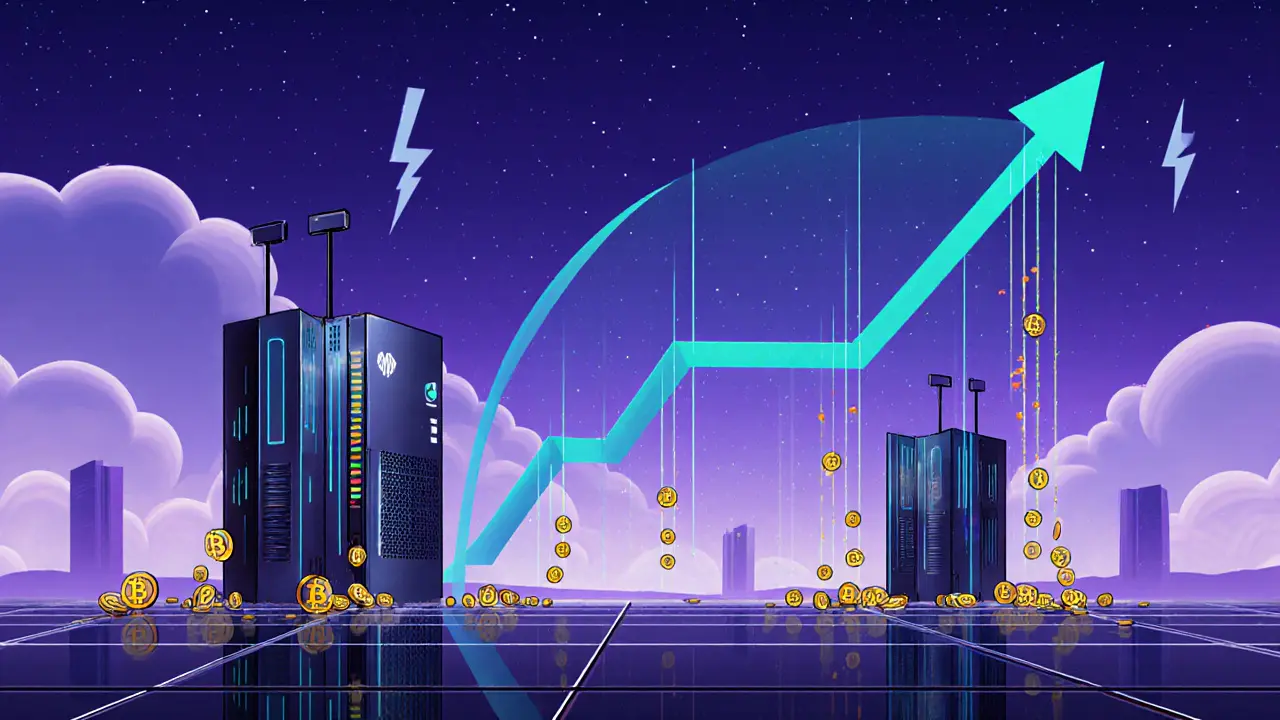 Jul, 2 2025
Jul, 2 2025
Bitcoin Block Reward Calculator
Calculate how Bitcoin's block rewards decrease over time and how it impacts the inflation rate and total supply.
Projected Values
Next Halving Reward: 3.125 BTC
Next Halving Date: April 19, 2024
New Annual Inflation Rate: 1.0%
Estimated Total Supply After Halving: 21,000,000 BTC
Halving Timeline
When you hear people talk about crypto inflation, the first thing that comes up is block rewards. Those payouts to miners are not just a sweetener - they are the engine that drives the supply of coins and, ultimately, the inflation rate of a network.
Block rewards are a protocol‑defined amount of new cryptocurrency issued to the miner or validator that successfully creates the next block. In proof‑of‑work (PoW) systems like Bitcoin, the reward is the only way new coins enter circulation, making it a direct lever of monetary policy.
Why block rewards matter for inflation
Inflation, in any monetary system, is the rate at which the total supply grows relative to demand. In traditional fiat, central banks can print money at will, causing supply spikes that can be hard to predict. By contrast, block rewards follow a rigid schedule coded into the blockchain’s consensus rules. This predictability lets market participants see exactly how much new supply will appear each year.
Bitcoin’s design illustrates the point perfectly. Its supply cap is 21million BTC, and the reward started at 50BTC per block in 2009. Every 210,000 blocks (about four years) the reward halves - a process known as the halving. After the fourth halving on 19April2024, the reward dropped to 3.125BTC, cutting the annual inflation rate from roughly 2% to just about 1%.
How the halving works
The halving is a simple mathematical rule: after a set number of blocks, the block reward is divided by two. Because the block time is fixed at ten minutes, the network creates about 144 blocks per day, or 52,560 blocks per year. Multiply that by the reward, and you get the yearly new supply.
Here’s a quick snapshot:
- 2009‑01‑03: 50BTC per block - ~7.3M BTC added in the first year (≈ 34% inflation)
- 2012‑11‑28: 25BTC per block - ~3.6M BTC added (≈ 17% inflation)
- 2016‑07‑09: 12.5BTC per block - ~1.8M BTC added (≈ 8% inflation)
- 2020‑05‑11: 6.25BTC per block - ~0.9M BTC added (≈ 4% inflation)
- 2024‑04‑19: 3.125BTC per block - ~0.45M BTC added (≈ 2% inflation)
Each step halves the rate at which new coins appear, making Bitcoin’s inflation curve a smooth, predictable decline toward zero as we approach the 2140 supply deadline.
Comparing other crypto monetary models
Not every blockchain uses a halving schedule. Let’s look at three popular alternatives and see how they affect inflation.
| Network | Reward Mechanism | Current Annual Inflation (≈) | Supply Cap |
|---|---|---|---|
| Bitcoin | Fixed‑schedule halving every 210k blocks | 1% (post‑2024 halving) | 21M BTC |
| Ethereum (PoS) | Validator staking rewards, dynamically adjusted | ≈ 0.5% (2024) | No hard cap, but ETH issuance slows over time |
| Monero | Tail emission of 0.6XMR per minute forever | ≈ 1% perpetual | Unlimited, but tail emission keeps inflation low |
| Bitcoin Cash | Same halving schedule as Bitcoin | ≈ 1% (2024) | 21M BCH |
Bitcoin’s clear‑cut halving makes its inflation rate the most transparent of the bunch. Ethereum’s switches to a proof‑of‑stake model, where rewards adjust based on the total amount staked, giving a slightly lower but still predictable inflation. Monero’s tail emission guarantees a constant, modest inflation forever, which some see as a way to keep mining incentives alive after the main supply phase ends.

Implications for miners and network security
As block rewards shrink, miners must rely on transaction fees to stay profitable. The Bitcoin network’s hashrate jumped from 13.2EH/s before the 2020 halving to over 627EH/s by the 2024 halving - a 4,600% increase. This surge shows that, so far, lower rewards haven’t scared miners away; the value of BTC and rising fees have compensated.
However, forecasts warn that by 2040 fees alone may need to average around $50 per transaction to keep miners incentivized. If fees lag, the security model could face a “tragedy of the commons” where fewer miners secure the chain, raising the risk of attacks.
To mitigate this, developers propose upgrades like Taproot Assets (BIP‑371) that improve transaction efficiency, potentially boosting fee revenue per block. Parallelly, some mining pools are diversifying into ancillary services such as decentralized finance (DeFi) liquidity provision to supplement earnings.
Real‑world sentiment and market impact
Investors love the predictability. A Fidelity Digital Assets 2024 survey found 78% of institutional respondents cited Bitcoin’s decreasing inflation schedule as a key factor in allocation decisions - far higher than the 32% who mentioned Ethereum’s model.
Retail sentiment mirrors this. On Reddit’s r/Bitcoin, more than 60% of comments around the 2024 halving were positive, highlighting the “known supply shock” as a buying signal. Yet, professional miners voiced concerns: after the 2028 halving, many project a 35% revenue dip unless fees rise dramatically.
Financial products have sprung up around these events. Grayscale’s Bitcoin Halving Fund raised $427million in early 2024, allowing investors to bet on the price swing that typically follows a reward cut.
Policy considerations and regulation
Regulators are beginning to notice the macroeconomic uniqueness of algorithmic inflation. The U.S. SEC’s March2024 guidance explicitly mentioned Bitcoin’s programmed supply reduction as a material difference from other digital assets when assessing investment risk.
Meanwhile, the Bank for International Settlements warned that the transition to fee‑based security remains the “greatest unsolved economic challenge” for Bitcoin, urging policymakers to monitor how fee markets evolve.

What the future holds
Looking ahead, three forces will shape the relationship between block rewards and inflation:
- Further halvings: The next event is slated for August2028, dropping the reward to 1.5625BTC and halving inflation again.
- Fee market dynamics: As block space remains scarce, fees are expected to rise, but if layer‑2 solutions like the Lightning Network achieve massive adoption, on‑chain fees could stay modest.
- Protocol upgrades: Innovations that increase throughput (e.g., Taproot Assets, Schnorr signatures) could boost miner revenue per block without changing supply.
In the long run, Bitcoin’s inflation will asymptotically approach zero, while the supply cap stays fixed. That scarcity is the core argument for many analysts who predict multi‑million‑dollar valuations by 2030. Yet, the economics of a reward‑less network remain an open question - will transaction fees alone sustain the hashrate, or will new consensus mechanisms emerge?
Key Takeaways
- Block rewards are the primary driver of cryptocurrency inflation in PoW networks.
- Bitcoin’s halving schedule creates a transparent, declining inflation path that drops from >30% at launch to ~1% after the 2024 event.
- Alternative models (Ethereum PoS, Monero tail emission) achieve low inflation but with different security incentives.
- Miners face a future shift from reward‑dominant earnings to fee‑dominant earnings, raising security concerns.
- Institutional investors value predictable inflation, making Bitcoin a favored store of value despite the upcoming reward decline.
Frequently Asked Questions
What exactly is a block reward?
A block reward is the amount of new cryptocurrency that the miner or validator receives for successfully creating the next block in a blockchain. In Bitcoin, this reward is cut in half every 210,000 blocks, forming the basis of its inflation schedule.
How does a halving affect Bitcoin’s price?
Historically, each halving has been followed by a multi‑month rally because the reduced supply growth creates a scarcity premium. However, price moves also depend on broader market sentiment and macro factors.
Will transaction fees be enough to secure Bitcoin after rewards disappear?
The consensus is mixed. Some analysts argue that a thriving fee market, boosted by layer‑2 adoption and protocol upgrades, can sustain security. Others warn that without sufficient fees, the network could become vulnerable.
How does Ethereum’s inflation model differ from Bitcoin’s?
Ethereum moved to proof‑of‑stake in 2022. Instead of block‑reward halvings, validators earn staking rewards that adjust based on the total ETH staked, resulting in a lower, more flexible inflation rate around 0.5%.
What is a tail emission and which coins use it?
A tail emission is a permanent, low‑level issuance that continues forever. Monero uses a tail emission of 0.6XMR per minute, keeping inflation around 1% indefinitely.
Deborah de Beurs
July 2, 2025 AT 01:45Bitcoin’s halving isn’t just a cute sci‑fi timeline, it’s a ruthless economic experiment that slashes new supply like a guillotine on inflation. Every four years the miners watch their spreadsheets melt as the block reward halves, yet the market seems to love the drama more than the cash flow. The 2024 cut to 3.125 BTC pushed annual inflation to around 1%, and the price rally that followed proved that scarcity hype still fuels buying frenzies. But let’s not kid ourselves: miners are now scrambling for fee revenue, and the fee market is a wild west where transaction spammers can dilute earnings. The massive hash‑rate jump from 13 EH/s to 627 EH/s between 2020 and 2024 shows that the ecosystem can absorb the squeeze, but it also signals a race to the bottom on profitability. If transaction fees stagnate, we could see a wave of miners exiting, which would drop the hashrate and lower network security. Some argue that layer‑2 solutions like Lightning will siphon demand off‑chain, further starving on‑chain fees. Others claim that upcoming protocol upgrades-Taproot Assets, Schnorr signatures-will cram more value into each block, boosting fee density. The question is whether those upgrades can offset the long‑term trend toward fee‑only security. Institutional investors love the predictability of a hard‑coded supply curve, yet they also worry about the tail risk of a reward‑free world. A diverse mining strategy, including DeFi liquidity provision, might become the new norm to stay afloat. In short, block rewards shape inflation, but the future of security hinges on a fee market that can evolve faster than the halving schedule.
Sara Stewart
July 6, 2025 AT 11:19Great breakdown! The halving mechanism is a classic example of algorithmic monetary policy, and the data you showed on inflation rates really drives the point home. With Bitcoin’s supply curve flattening, it’s no surprise that institutional capital is zeroing in on the predictable scarcity factor. Keep the analysis coming.
Laura Hoch
July 10, 2025 AT 20:52Reading this feels like watching a slow‑burn philosophical novel about value. When block rewards shrink, the network subtly asks us to redefine what security means-does it stay rooted in raw computational work, or does it shift toward a collective belief in transaction utility? The tail‑emission model of Monero is a fascinating counterpoint, preserving miner incentives indefinitely, albeit at a modest inflation rate. It makes you wonder if Bitcoin might someday adopt a hybrid approach, blending fee incentives with occasional, tiny emissions to keep the security fabric intact. Either way, the economics are a living lab for monetary theory.
Devi Jaga
July 15, 2025 AT 06:25Oh sure, let’s all cheer for the halving as if it magically solves everything. Meanwhile, real‑world miners are juggling power costs that look nothing like your neat charts.
Hailey M.
July 19, 2025 AT 15:59Wow!!! This post hits all the 🔥 points! The halving drama is like waiting for the next season of a binge‑worthy series. 🎬💥 And those fee market predictions? Total edge‑of‑your‑seat material. Can't wait to see how the Lightning Network will rewrite the script! 😎🚀
Kaitlyn Zimmerman
July 24, 2025 AT 01:32Interesting how Bitcoin uses a fixed schedule while other chains go for dynamic models i think it shows the trade off between predictability and flexibility
DeAnna Brown
July 28, 2025 AT 11:05Honestly, the whole halving hype is just a circus, but I gotta admit the scarcity narrative does give the US dollar a run for its money. If we keep mining fees up, we can still claim it’s the strongest digital gold out there. Go crypto!
Chris Morano
August 1, 2025 AT 20:39I think the community should keep an eye on the fee market while staying optimistic about upgrades. The network has shown resilience before.
Ikenna Okonkwo
August 6, 2025 AT 06:12Balancing act, indeed. The halving trims inflation, but if transaction fees don’t rise, we could see a security dip. Diversifying miner revenue streams might be the pragmatic path forward.
Bobby Lind
August 10, 2025 AT 15:45Wow! This is so insightful!!!
Jessica Cadis
August 15, 2025 AT 01:19From a neutral standpoint, the data on inflation trajectories across different networks is solid. It helps frame the discussion about future security models without bias.
Katharine Sipio
August 19, 2025 AT 10:52Thank you for the clear explanation. The halving schedule and its impact on inflation are now much easier to understand.
Shikhar Shukla
August 23, 2025 AT 20:25The article overlooks the governance complexities that arise when protocol upgrades aim to alter fee structures. A more rigorous analysis of stakeholder incentives would strengthen the argument.
Deepak Kumar
August 28, 2025 AT 05:59Love the energy here! Keep pushing those insights-miners need all the optimism they can get as we head toward the next halving.
Matthew Theuma
September 1, 2025 AT 15:32The precision of the numbers is impressive, though I did spot a minor typo in the 2024‑04‑19 entry-should be 0.45M not 0.45M. Overall, great job!
Carolyn Pritchett
September 6, 2025 AT 01:05Another piece of hype about halving, same old story. People will keep buying the hype until it crashes.